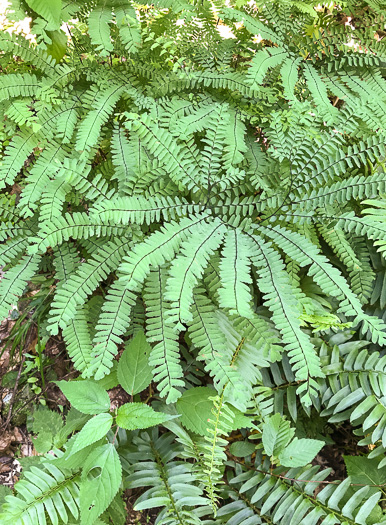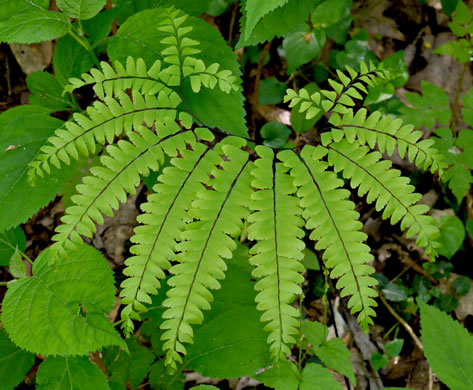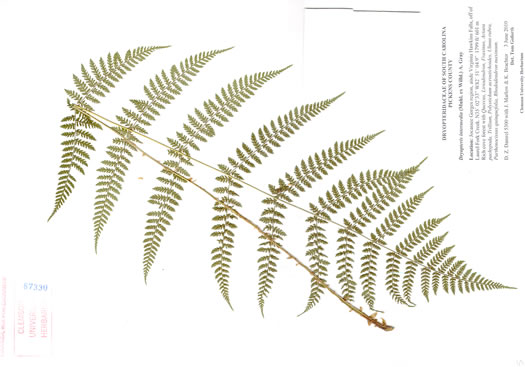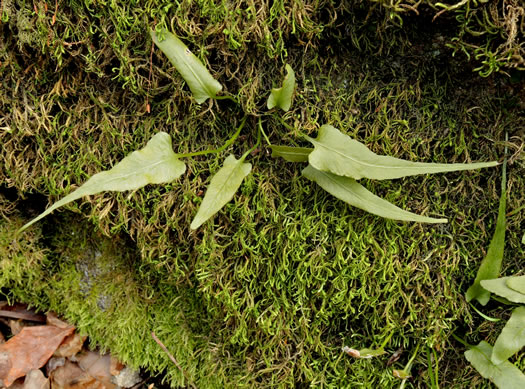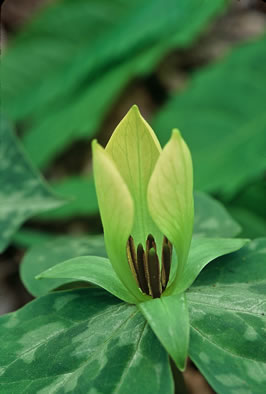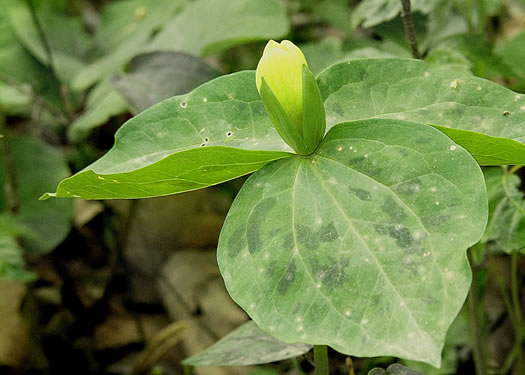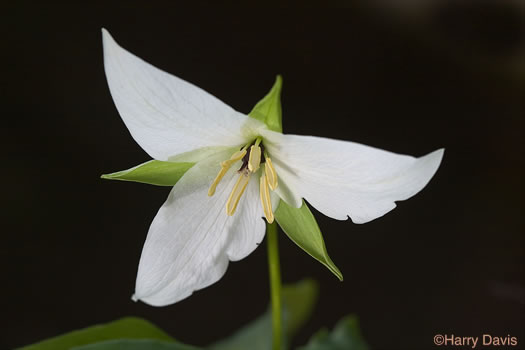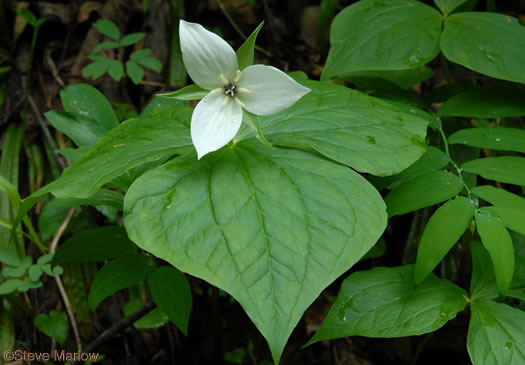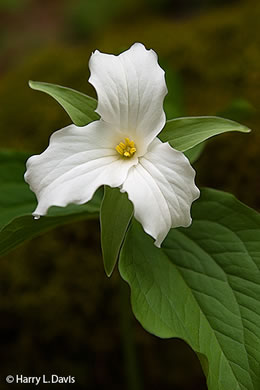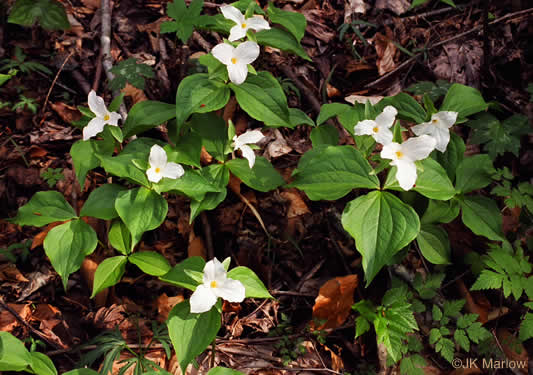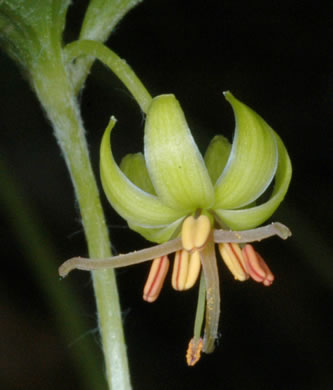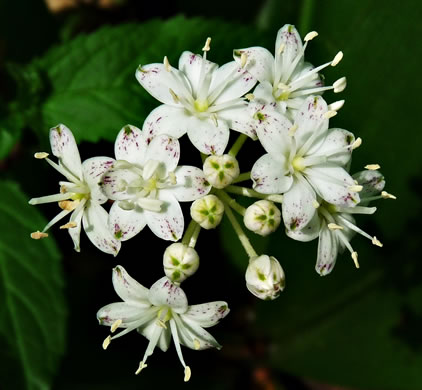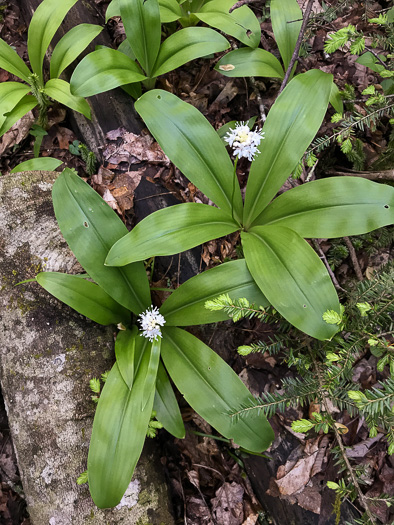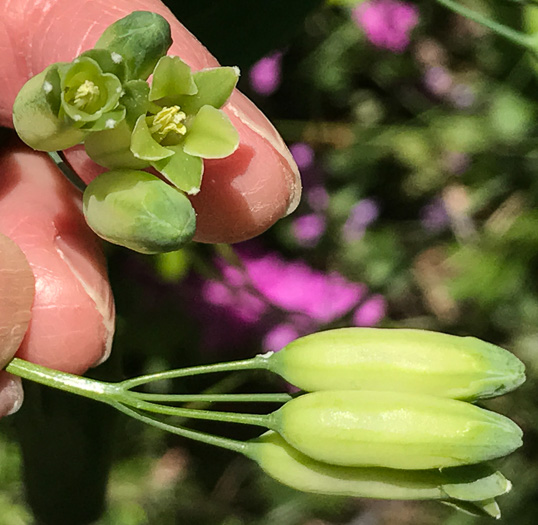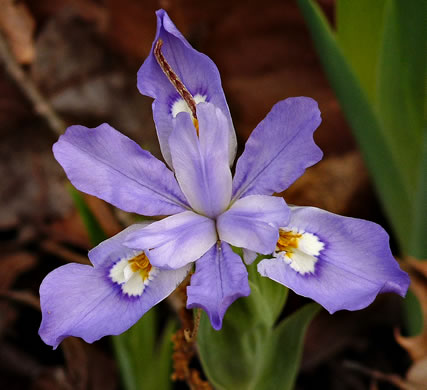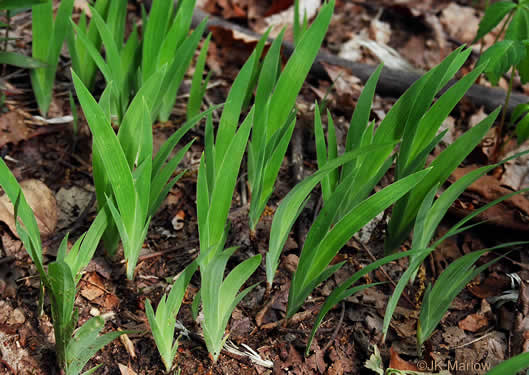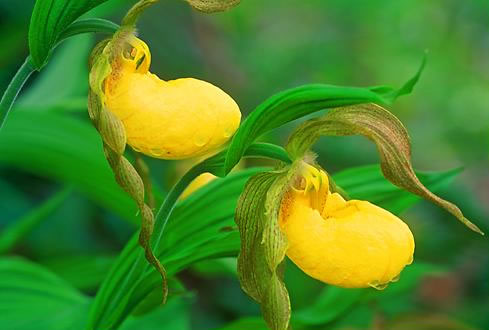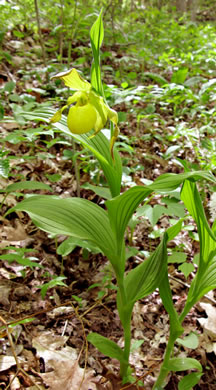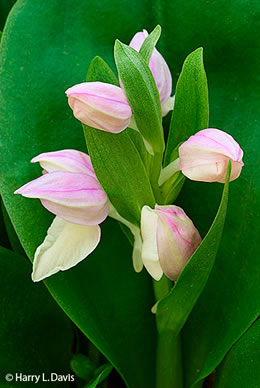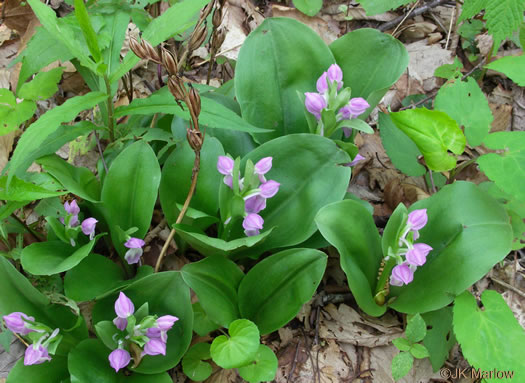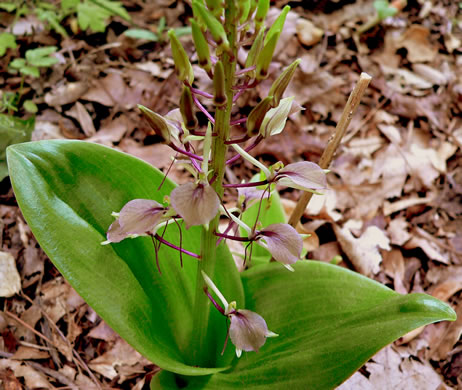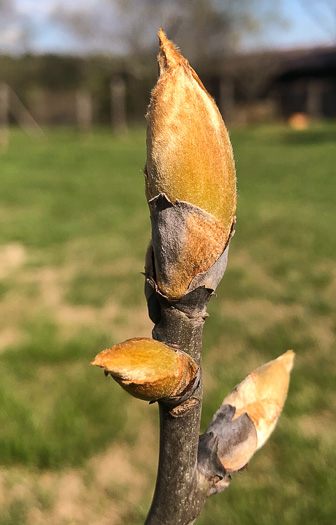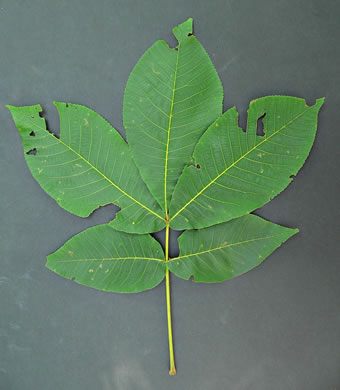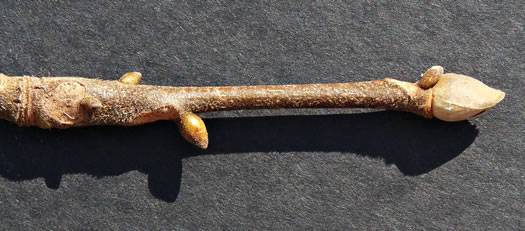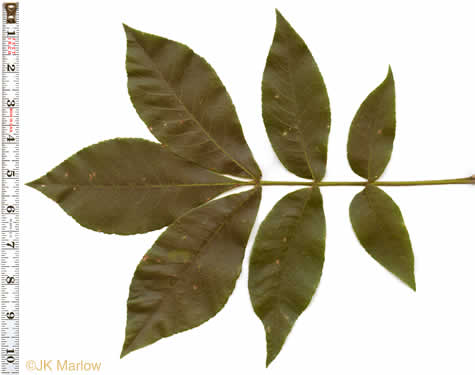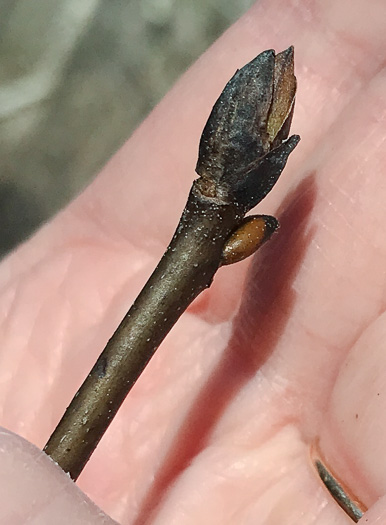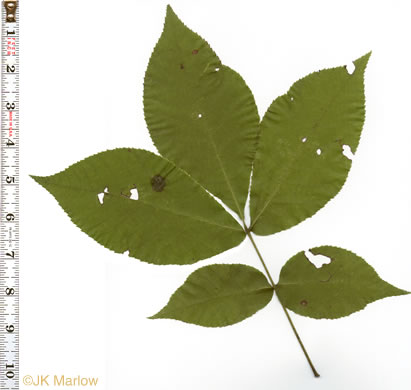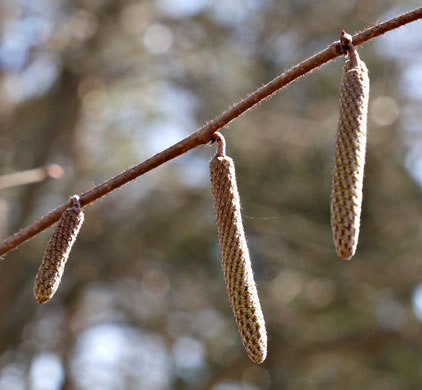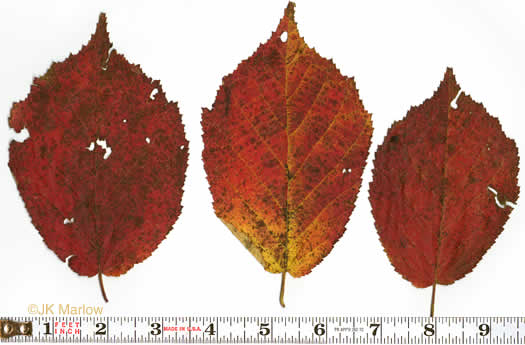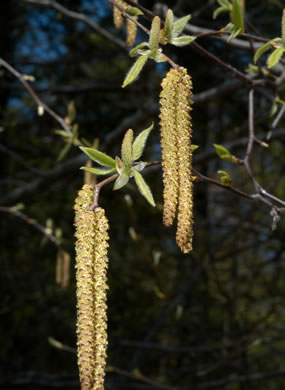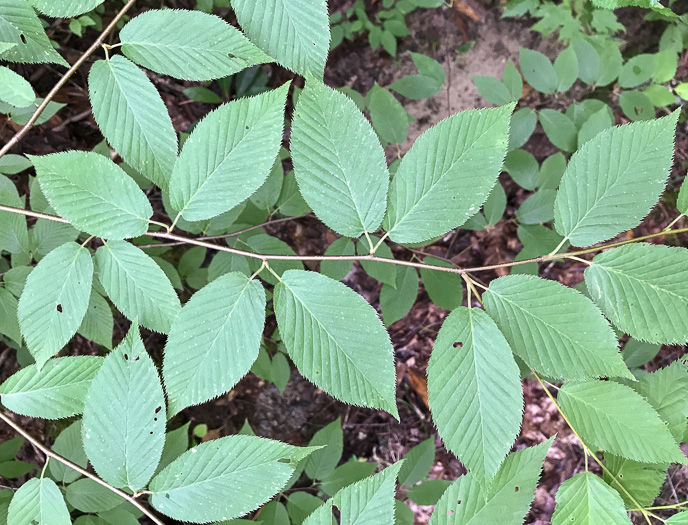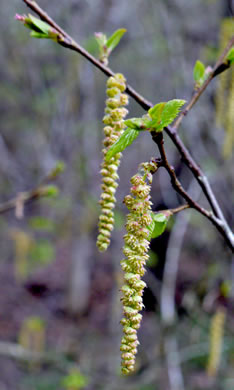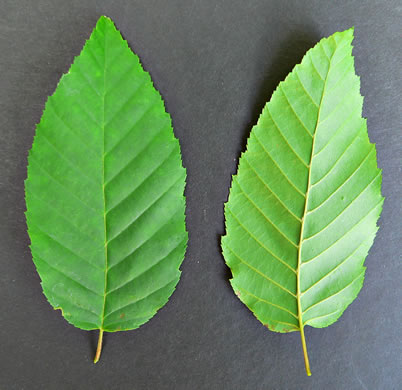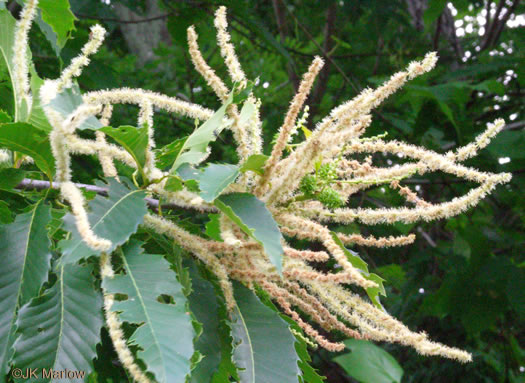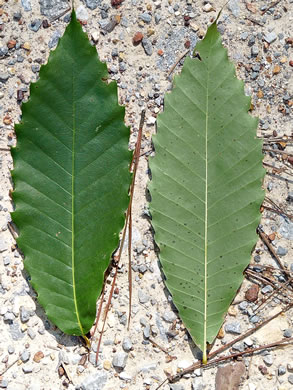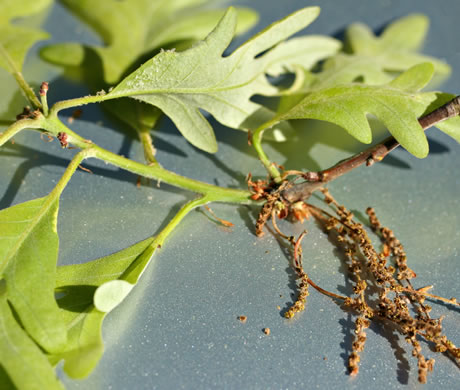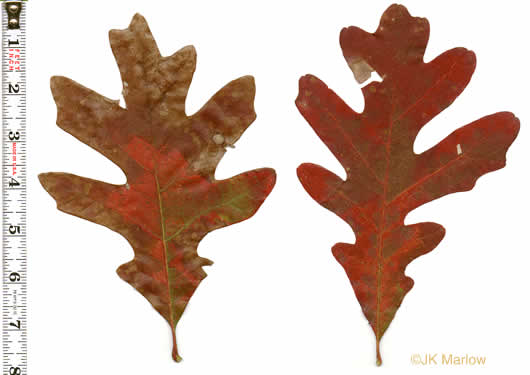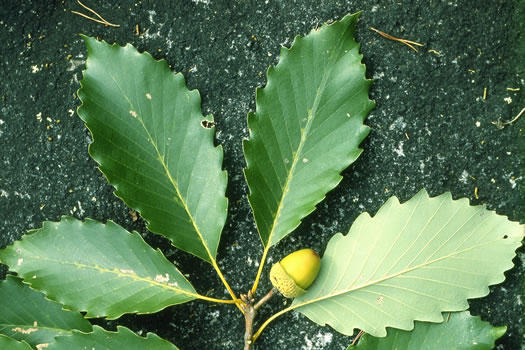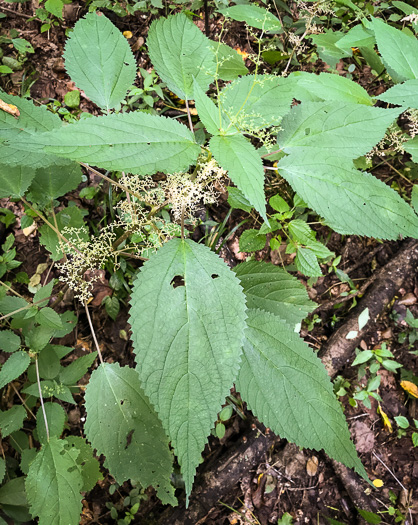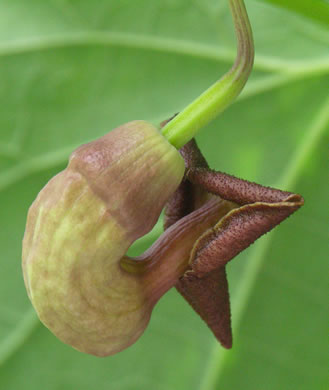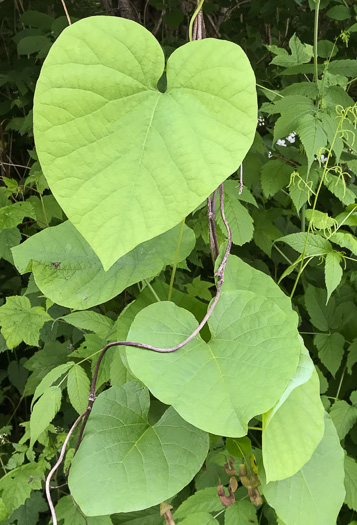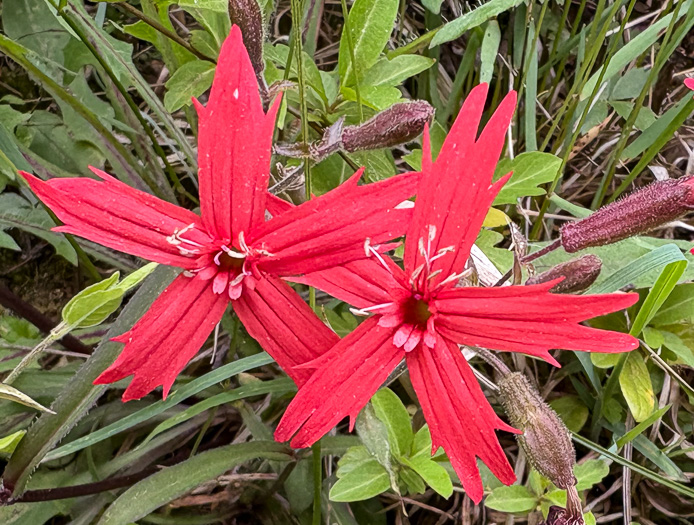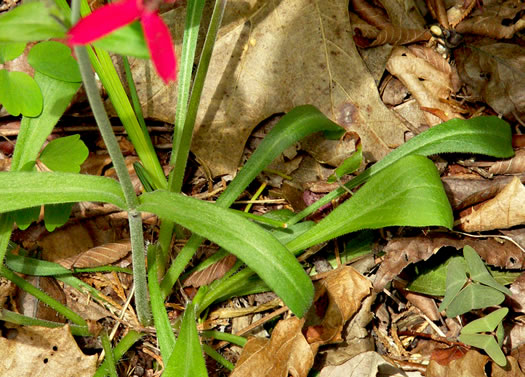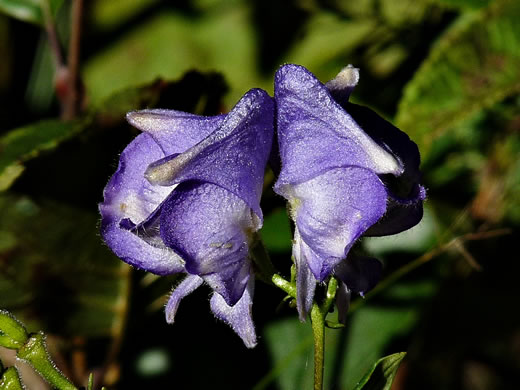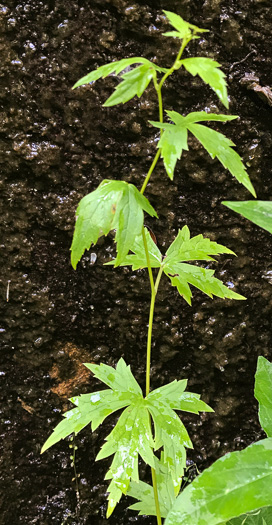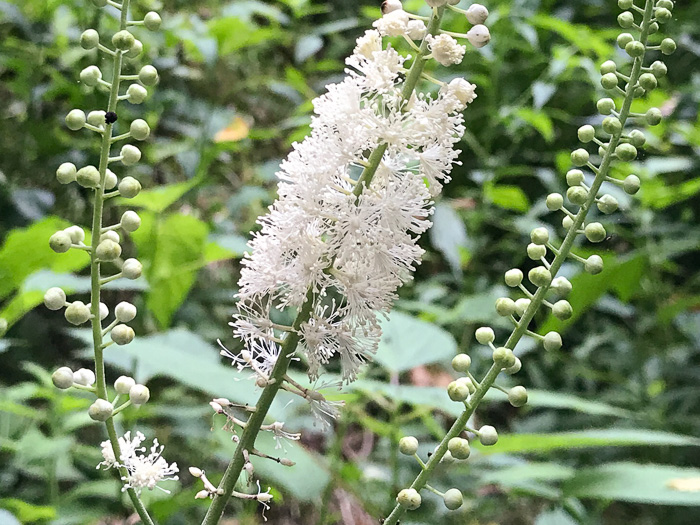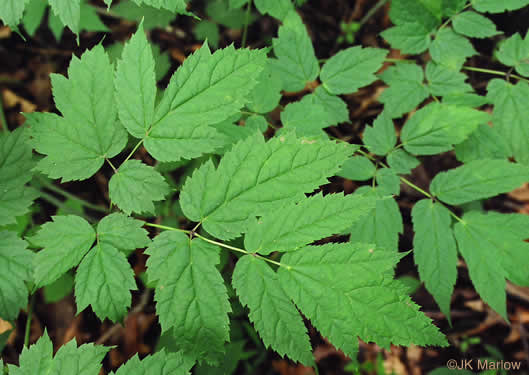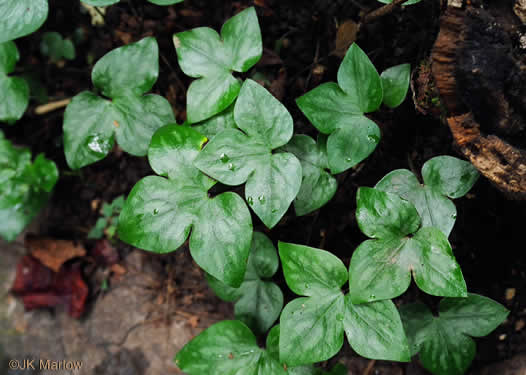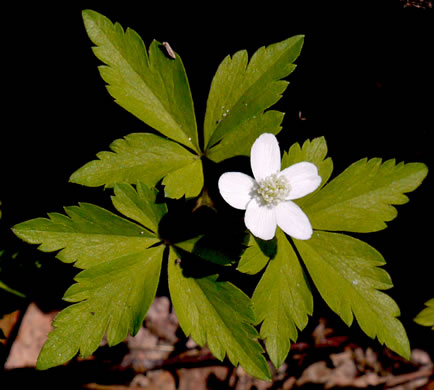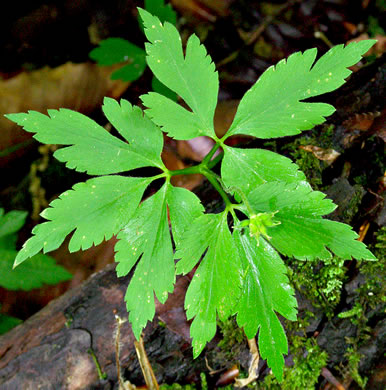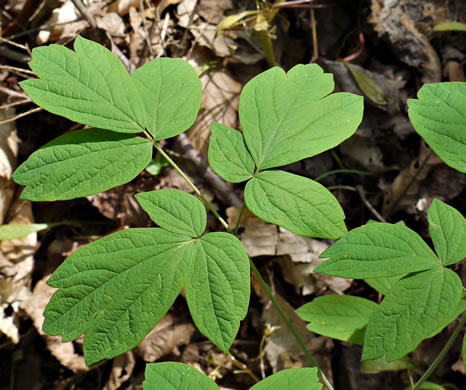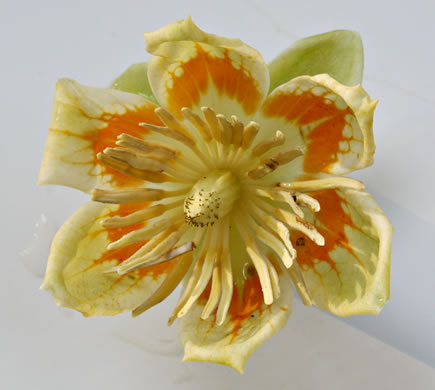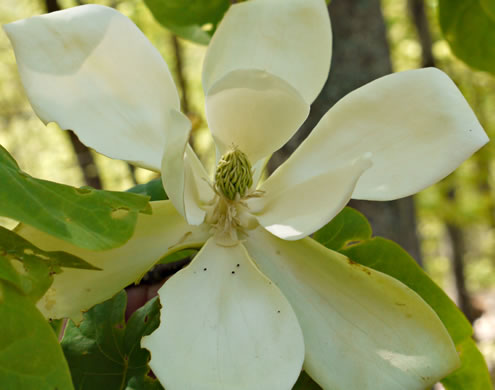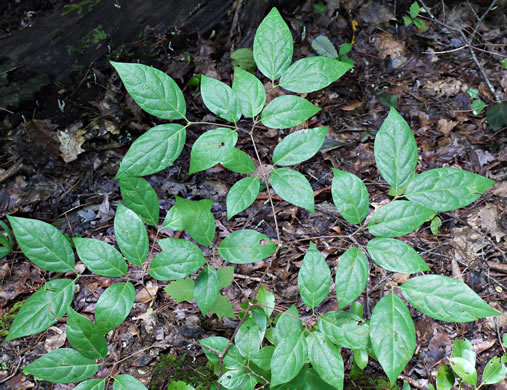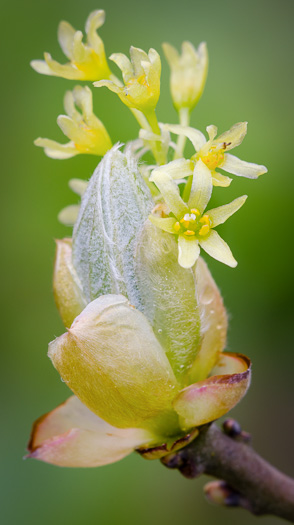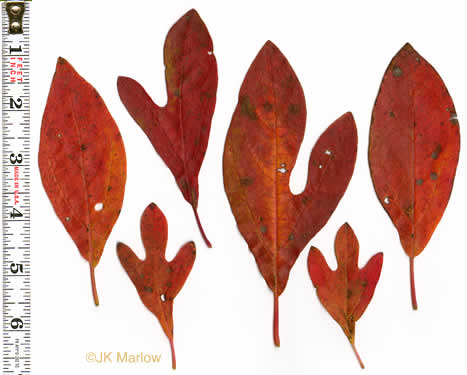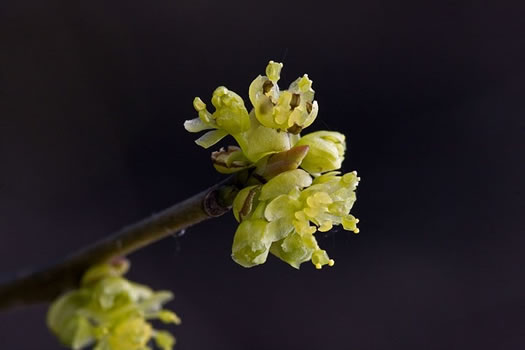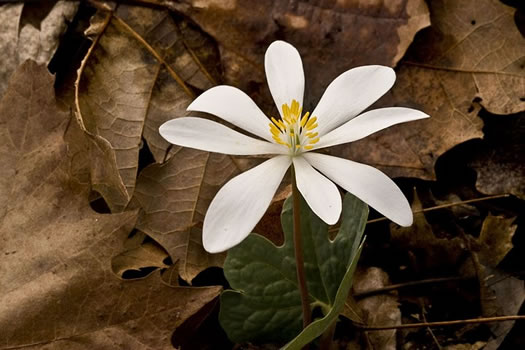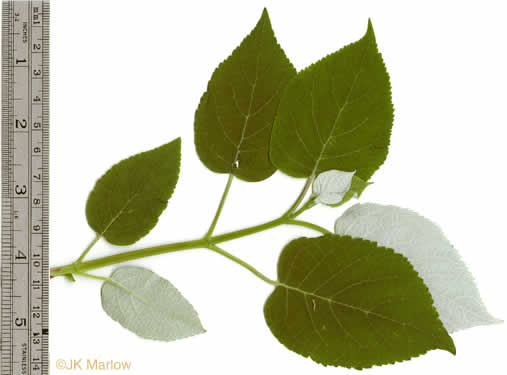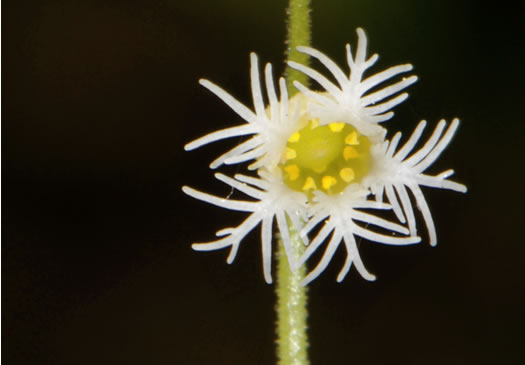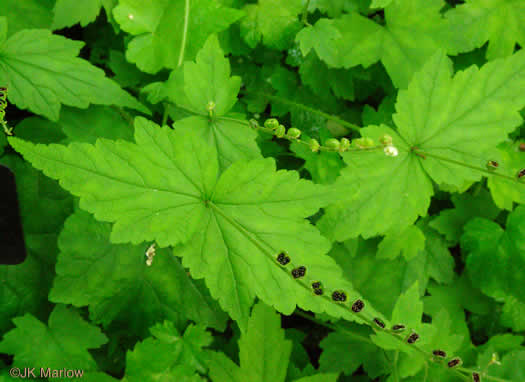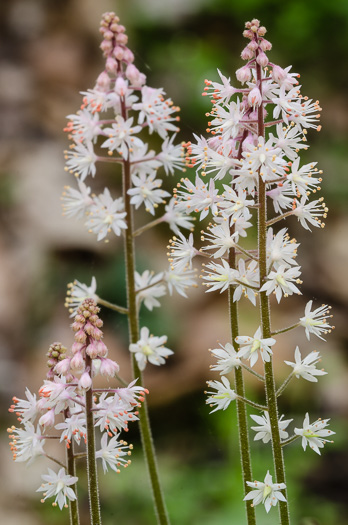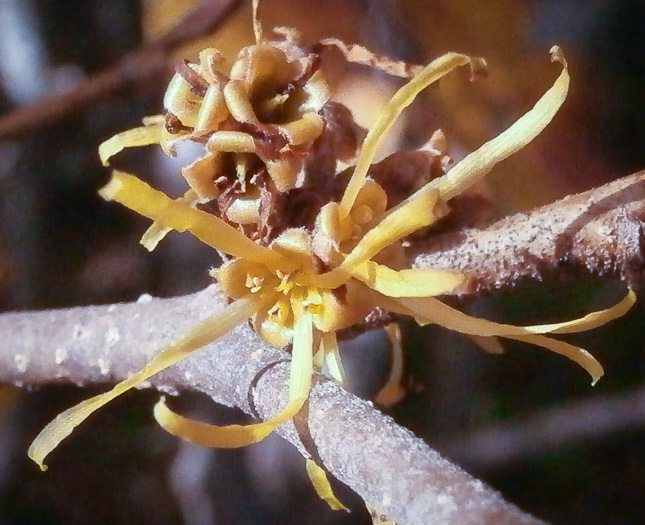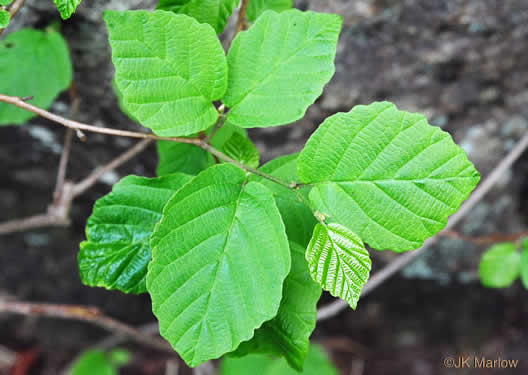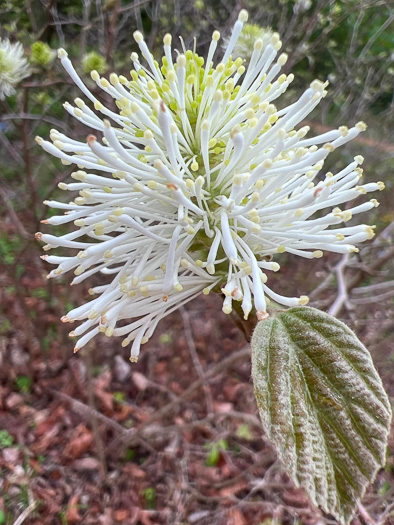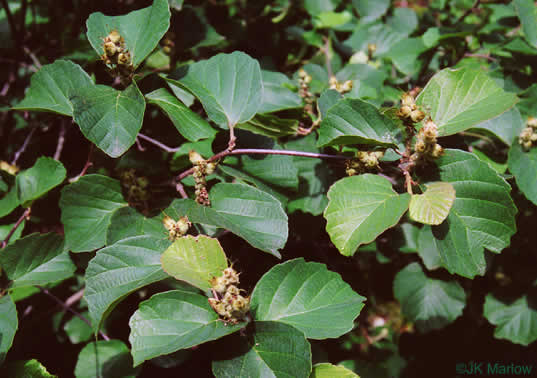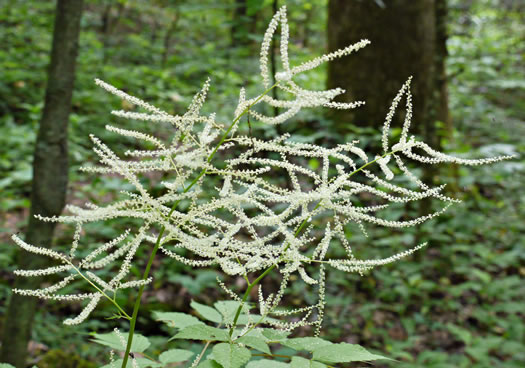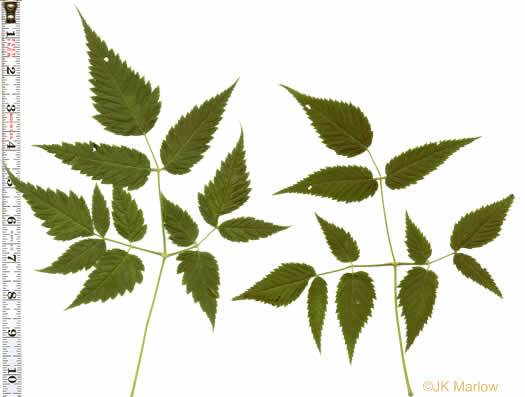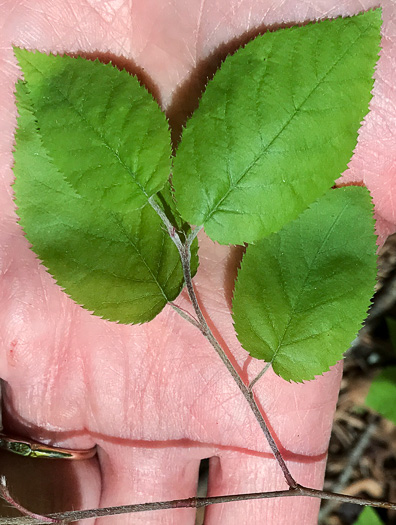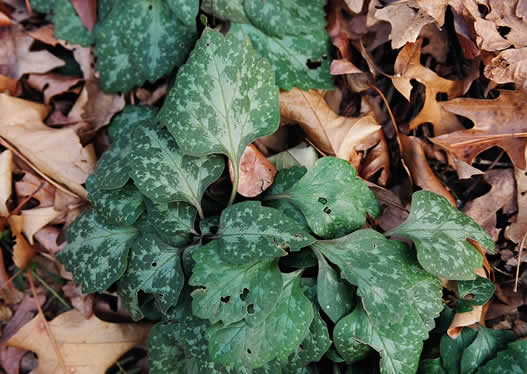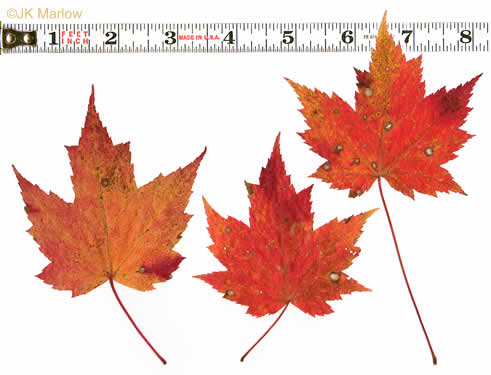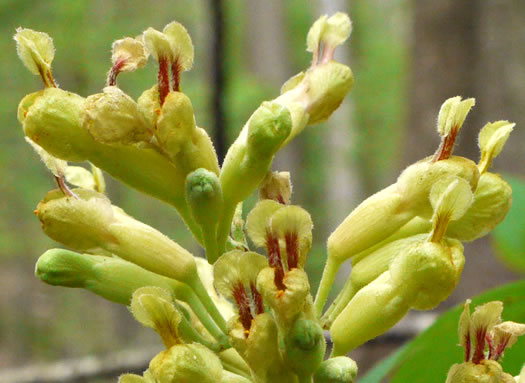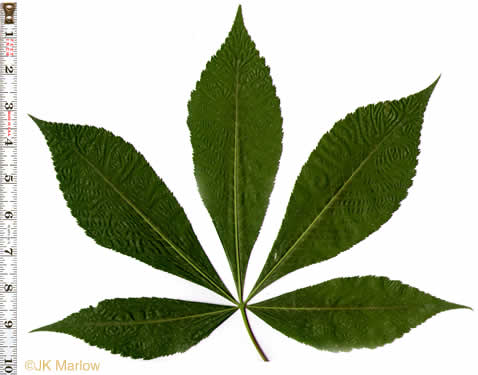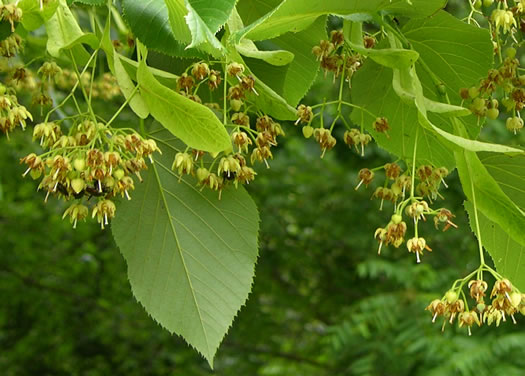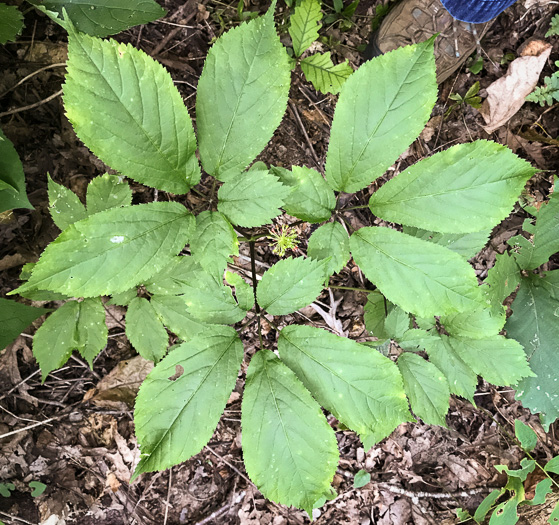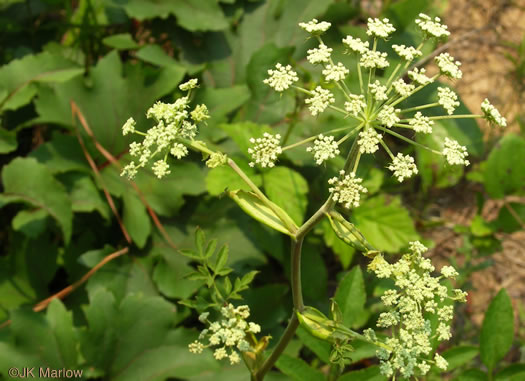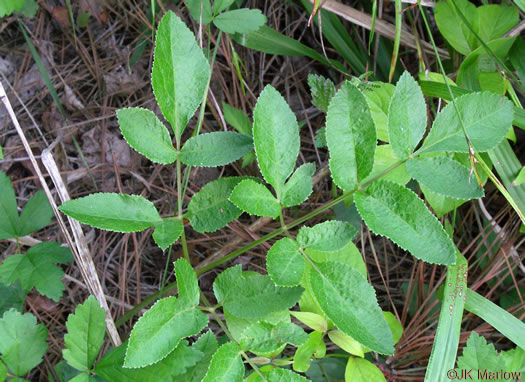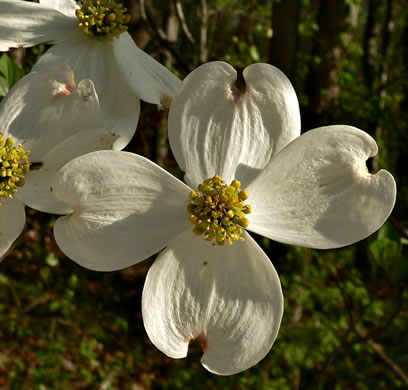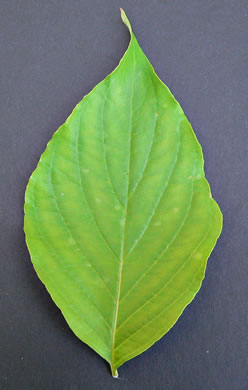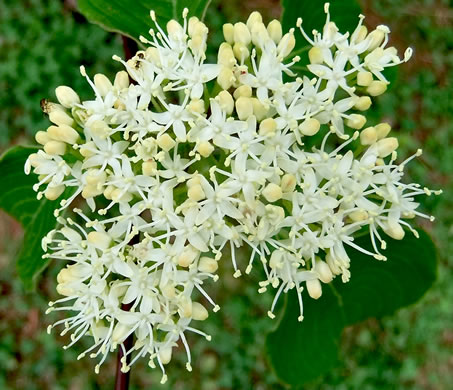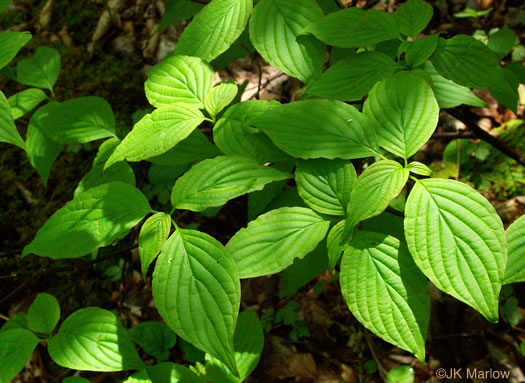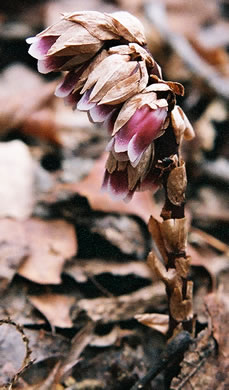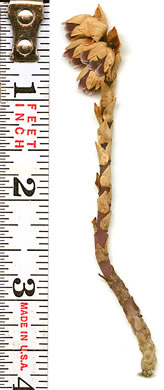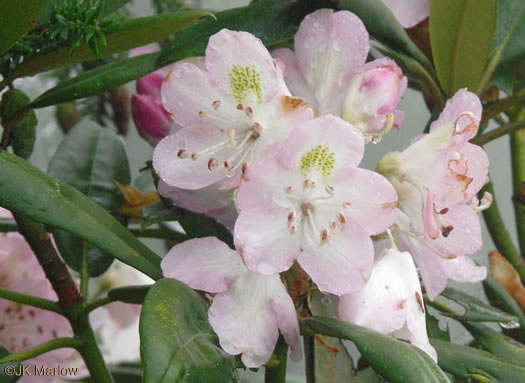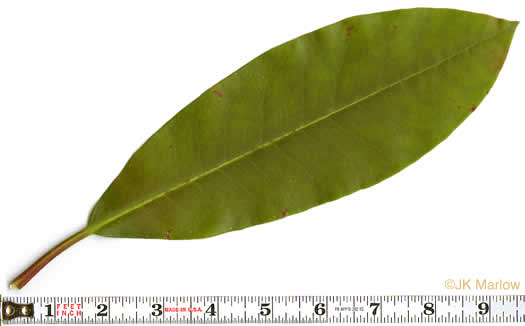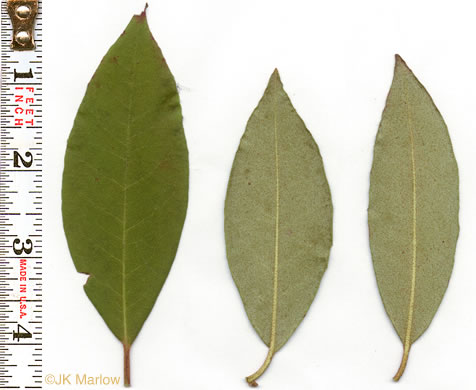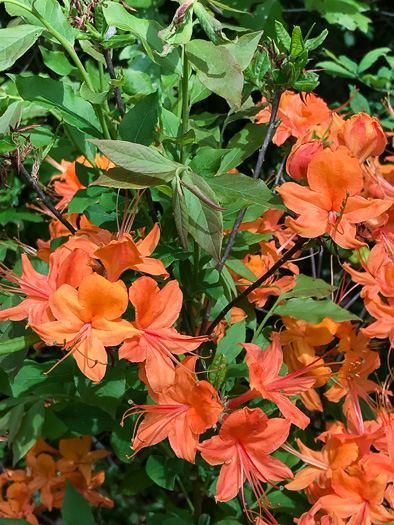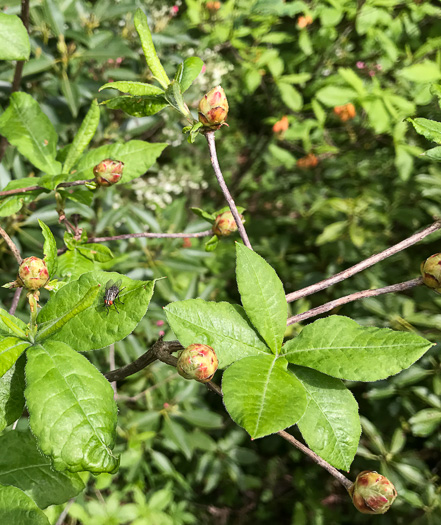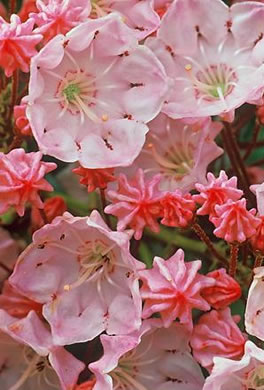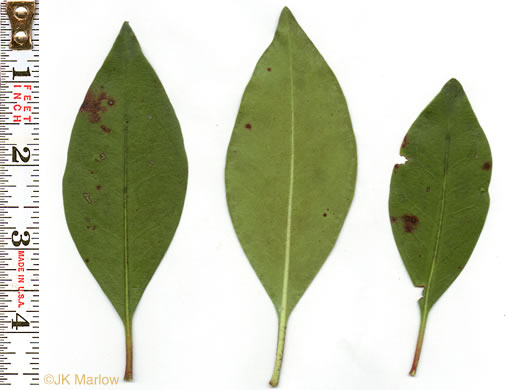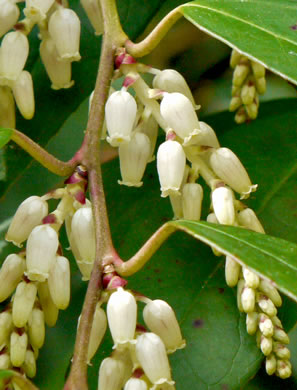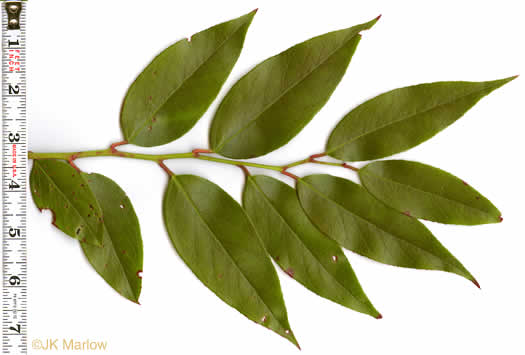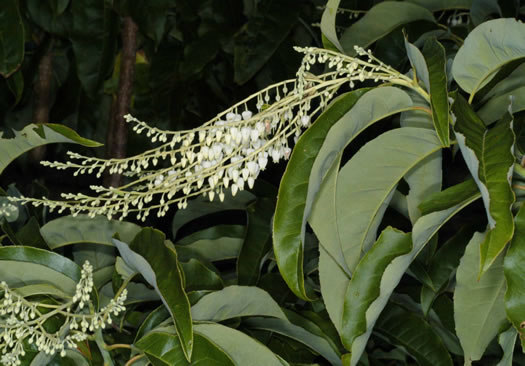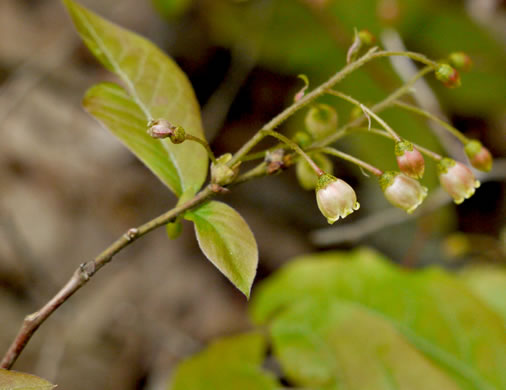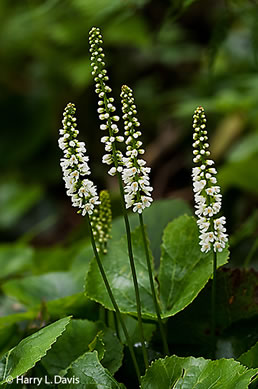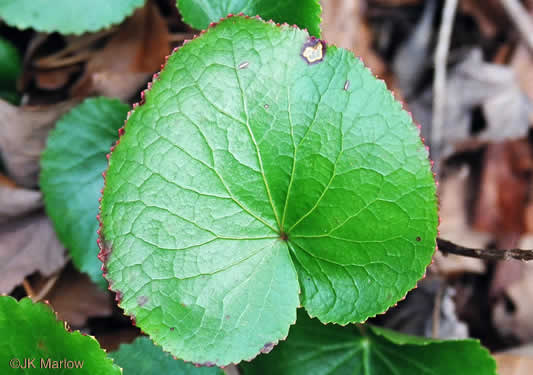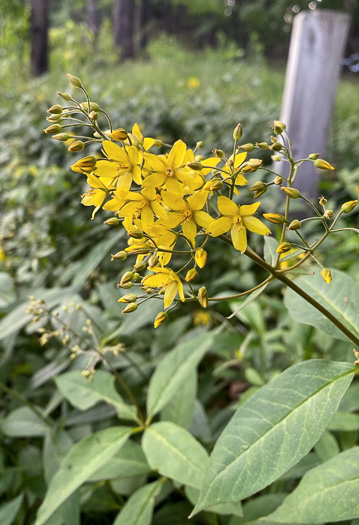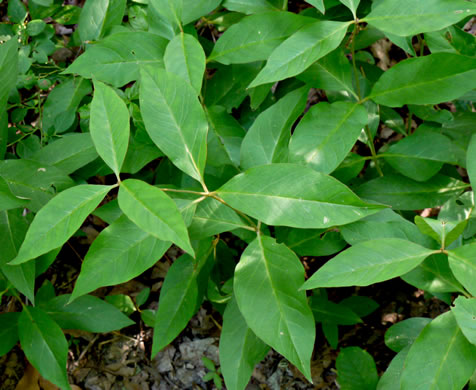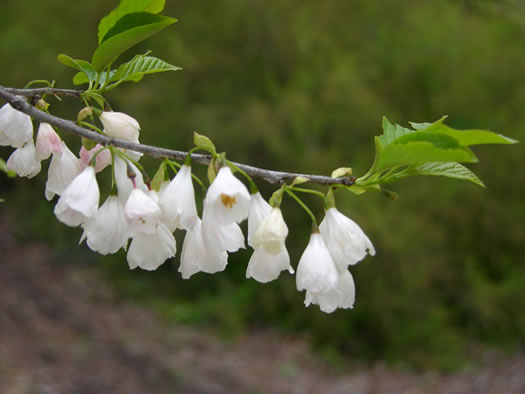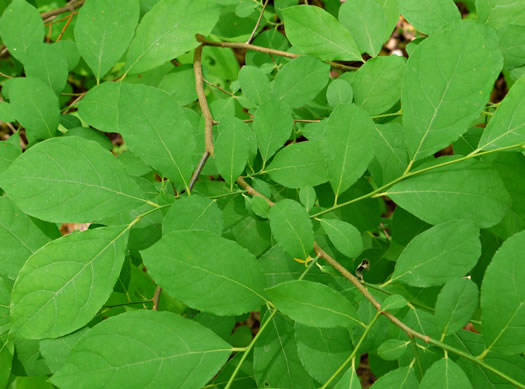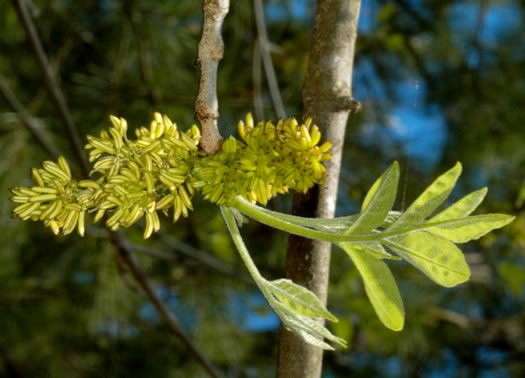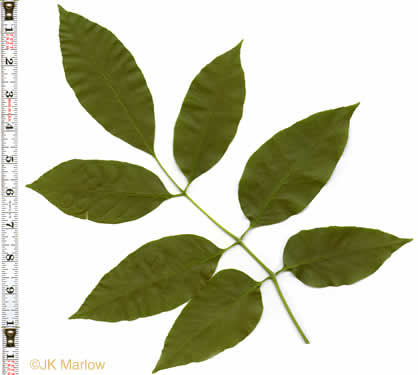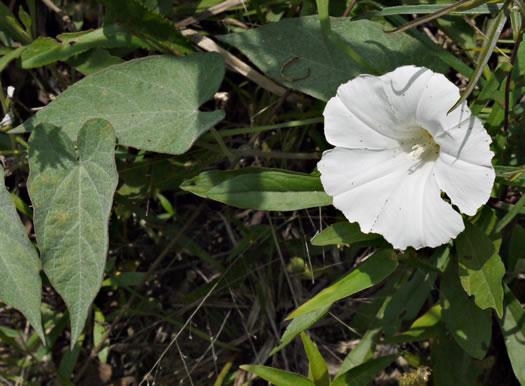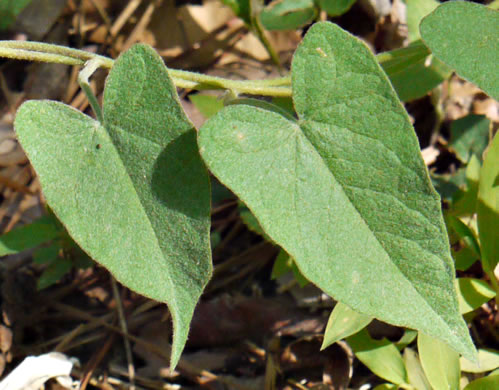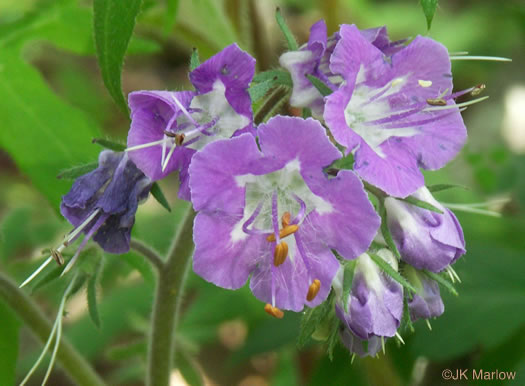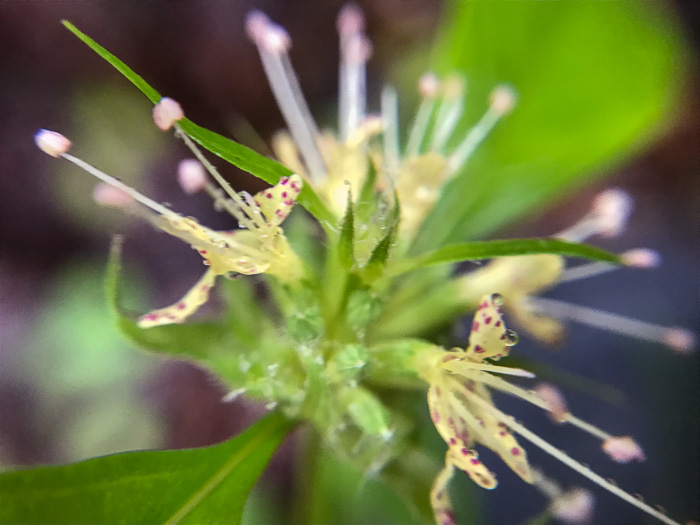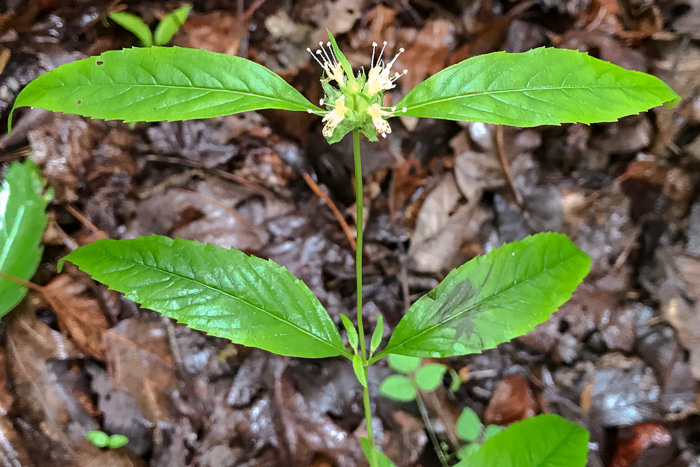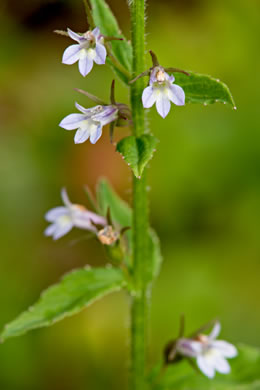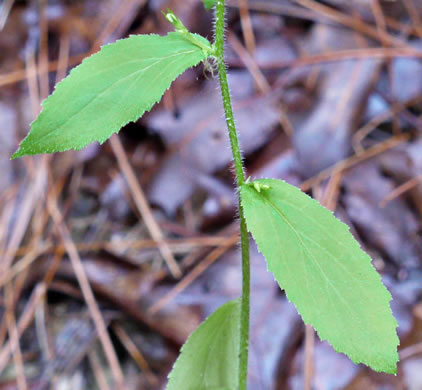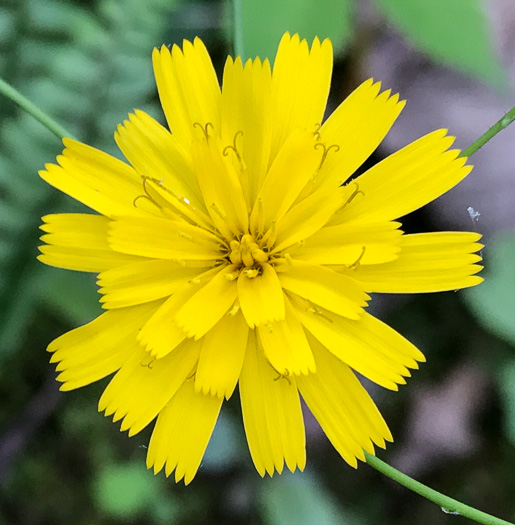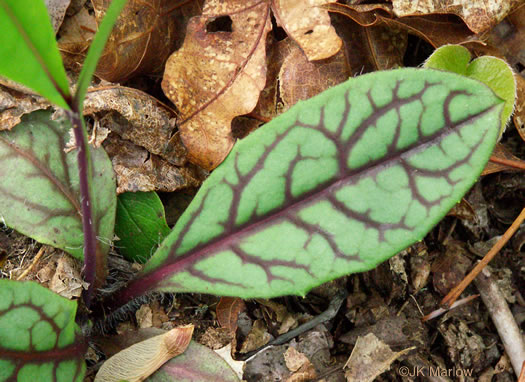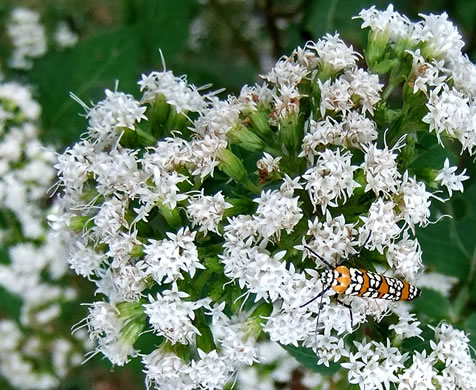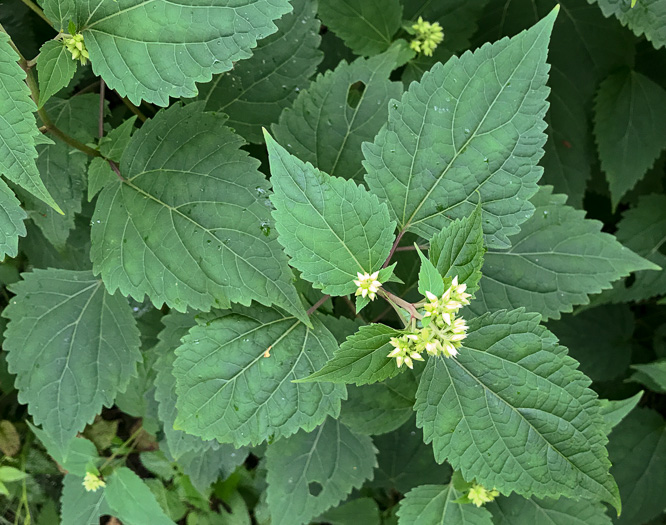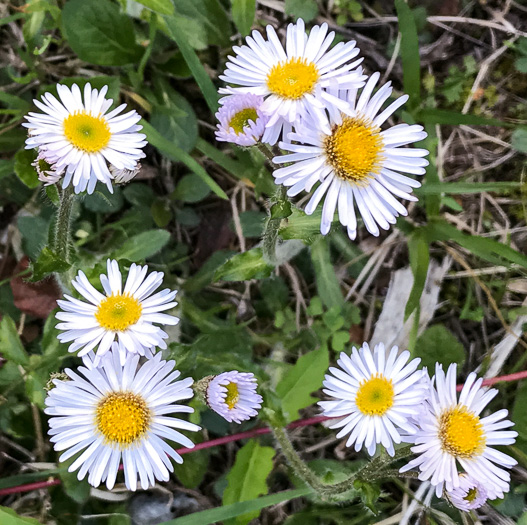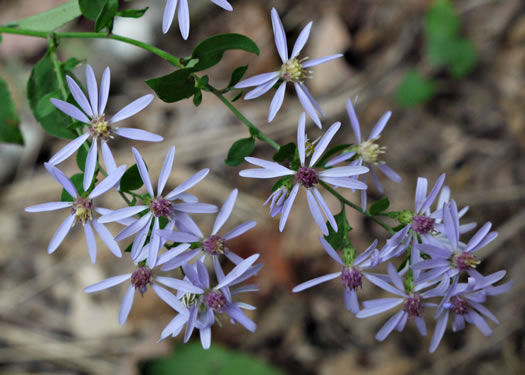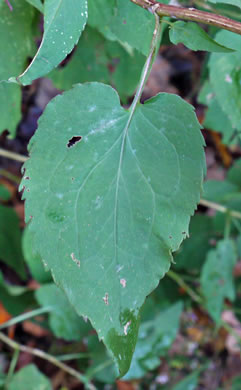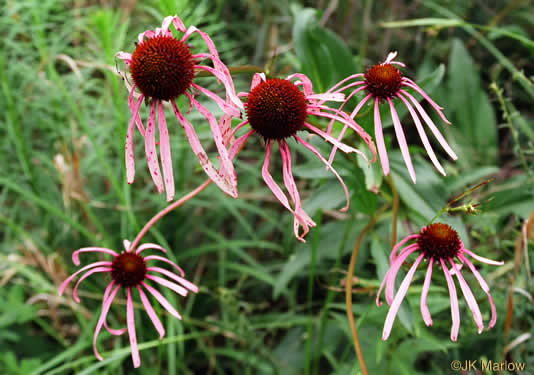South Carolina's Natural Wildflower Communities —
THE MOUNTAINS:
The deciduous forest communities
Cove forests / Chestnut oak forests / Woodland margins / Montane oak-hickory forests
Cove forests
Cove forests are the best known of the mountain communities and are appreciated by botanists and nature lovers for their diversity of plants in all strata, especially the herb layer. It is a mesic community, so it is always found in sheltered locations on the lower slopes of broad ravines or on broad flats adjacent to streams. It occasionally occupies midslope locations on north-facing slopes, especially where the soil is rich. The dictionary definition that fits the historical use of the term cove by early mountain residents is a “level area sheltered by hills or mountains.” Soils on these sites are typically deep and rich, and in South Carolina at least some are almost always associated with amphibolite, a metamorphic rock with a high content of the calcium-rich mineral hornblende. The pH of the soil in rich cove forests is always above 6.0. Cove forests do occur in the piedmont, but they are rare.
The dense canopy includes a variety of mesophytic trees. Typical trees include
Appalachian basswood (Tilia heterophylla),
yellow buckeye (Aesculus octandra),
sweet birch (Betula lenta),
and northern red oak (Quercus rubra).
Other trees include
tulip tree (Liriodendron tulipifera),
American ash (Fraxinus americana),
beech (Fagus grandifolia),
and Canada hemlock (Tsuga canadensis).
Few oak species are present other than northern red oak.
The understory is usually sparse and includes such species as
flowering dogwood (Cornus florida),
hop hornbeam (Ostrya virginiana),
ironwood (Carpinus caroliniana),
common silverbell (Halesia tetraptera),
and Fraser magnolia (Magnolia fraseri).
The shrub layer is sparse but may be dense on acidic sites. Typical shrub species include
sweet-shrub (Calycanthus floridus var. laevigatus),
wild allspice (Lindera benzoin),
American hazelnut (Corylus americana),
pagoda dogwood (Cornus alternifolia),
snowy hydrangea (Hydrangea radiata),
and on acidic sites,
great laurel (Rhododendron maximum)
and mountain doghobble (Leucothoe fontanesiana).
The dense and diverse herb layer is characteristic of cove forests in the mountains, just as it is for basic-mesic forests in the piedmont. A great diversity of herbs may be present, but the species that are rare and distinctive to cove forests include
blue cohosh,
ginseng,
walking fern,
Canada enchanters'-nightshade,
and yellow lady’s-slipper.
Species that are found here and also in other communities include
sharp-lobed liverleaf,
bloodroot,
maidenhair fern,
common black cohosh,
common white snakeroot,
common foamflower,
Christmas fern,
wood-nettle,
dwarf crested iris,
lily-leaved twayblade,
thimbleweed (Anemone quinquefolia),
common blue wood aster,
speckled woodlily,
eastern goat's-beard,
showy orchis,
and other herbs typical of mesic forests in the mountains and piedmont.
Additional rarities that are found in only one or in a few sites include
sweet white trillium,
pale yellow trillium,
large-flowered trillium,
miterwort (Mitella diphylla),
fancy fern (Dryopteris intermedia),
goldie’s wood fern,
fernleaf phacelia,
mapleleaf waterleaf,
Allegheny spurge,
and Fraser's loosestrife.
Some botanists define a separate community, the acidic cove forest, for forests that have some of the mesophytic trees of the cove forests but whose shrub and herb layer is similar to those of the Canada hemlock forests. The observant naturalist will note that there are often transitional communities where two distinct communities meet. The transition zone between cove forests and adjacent forests seems to be especially wide.
Unlike many of the communities of the dry ridges and upper slopes in the mountains and piedmont, cove forests are not fire dependent. For the maintenance of diversity, they apparently do require disturbance in the form of canopy gaps, particularly in the tree and herb layers. High winds that topple tall trees are the main source for the creation of canopy gaps.
Chestnut oak forests
Chestnut oak may dominate forests in the inner coastal plain, the entire piedmont, and the mountains, but we restrict our definition of chestnut oak forests to the definition accepted by most ecologists: low to moderate elevation communities of the mountains and upper piedmont, where American chestnut (Castanea dentata) once dominated. Other chestnut oak dominated communities, including those associated with monadnocks and rock outcroppings, are included with the broadly defined oak-hickory forest. Chestnut oak forests in the mountains are found on low ridge tops and the upper slopes on any exposure, although they are more common on east- and west-facing slopes. In the upper piedmont, this forest type is rare and is only found at relatively high elevations, often on upper, north-facing slopes.
This community was the preferred community for American chestnut, which was once the most valuable tree in eastern North America. Fallen chestnut logs and old stumps are still abundant. Following devastation by chestnut blight in the early 1900s, American chestnut has been replaced by chestnut oak (Quercus montana) and scarlet oak (Q. coccinea), which now dominate the closed canopy of this sub-xeric community. Chestnut oak, in particular, is fire-tolerant, and the number of trees probably increases following fire and timber harvest. Additional canopy species include many of the dry to dry-mesic oaks and hickories; especially white oak (Q. alba) and mockernut hickory (Carya tomentosa) as well as black gum (Nyssa sylvatica), various pines, and occasionally, where chestnut oak forests border rocky ledges, Carolina hemlock (Tsuga caroliniana). Sprouts of American chestnut may dominate the subcanopy. Destruction by chestnut blight fungus at or just after the first flowering precludes this species ascension to canopy dominance. Additional understory trees include
sourwood (Oxydendrum arboreum),
sassafras (Sassafras albidum),
red maple (Acer rubrum),
and downy serviceberry (Amelanchier arborea).
The shrub layer may be dominated by tall heaths such as mountain laurel (Kalmia latifolia) and great laurel (Rhododendron maximum)or low heaths such as bear huckleberry (Gaylussacia ursina)and southern deerberry (Vaccinium stamineum var. melanocarpum) or by a mix of tall and low heaths. Occasionally the shrub layer is poorly developed, in which case herbaceous plant diversity increases. Gorge rhododendron (Rhododendron minus) and flame azalea (R. calendulaceum) sometimes produce spectacular displays. The rare mountain witch-alder (Fothergilla major) is sometimes found here. This community is not known for its spring wildflower diversity, and although herb cover is sparse, some interesting species are present, including
galax (Galax urceolata),
trailing arbutus (Epigaea repens),
veiny hawkweed (Hieracium venosum),
Solomon's seal (Polygonatum biflorum),
and Indian cucumber-root (Medeola virginiana).
Knowledgeable naturalists can let their nose lead them to a colony of the seldom-seen sweet pinesap (Monotropsis odorata), whose cinnamon-scented flowers make the task of discovery at least possible, if not easy.
Because earlier logging operations took only quality hardwoods, leaving behind the poor quality trees, and because chestnut oak seldom grows straight and true as is desired by lumberman, most of the existing stands of chestnut oak forests are dominated by large, inferior chestnut oaks. Restoring these stands to their original high quality will be a challenge.
Woodland margins
Woodland margin communities include herbs with high light requirements that are not typical of ruderal environments. Designating such a community would not be necessary if fire had not been suppressed for so long. Several very rare species are largely restricted to this community, including
smooth purple coneflower (Echinacea laevigata),
Blue Ridge bindweed (Calystegia sericata),
and Fraser’s loosestrife (Lysimachia fraseri).
These rare species are nearly confined to the woodland margins along roads, usually old logging roads. All respond well to fire. If natural pine-oak woodlands were subjected to periodic fire, these species probably would occur there. In fact, at Pine Mountain in the Andrew Pickens District of the Sumter National Forest, where fire is now being employed as a management tool, populations of both Blue Ridge bindweed and smooth purple coneflower have increased dramatically. Efforts to use fire to restore the pine-oak heath community at the Buzzards Roost Heritage Preserve also have increased the abundance and flowering frequency of Blue Ridge bindweed.
Other dry woodland species, such as hairy angelica and Indian-tobacco, are most abundant in openings or in woodland margins along roads. Species such as Robin's-plantain and fire pink are most obvious in the moist to dry woodland margins.
Montane oak-hickory forests
Montane oak-hickory forests are a high elevation variant of the oak-hickory forests that are common in the piedmont and mountains. These forests are generally found at elevations above 2500 feet, either on ridge tops or on upper slopes that slope gently and are exposed but not rocky. This community occurs in high-calcium soils. The canopy is dominated by oaks and hickories, with
white oak (Quercus alba),
northern red oak (Q. rubra),
chestnut oak (Q. montana),
pignut hickory (Carya glabra),
and shagbark hickory (C. ovata)
most common. Tulip tree is usually present, and it may be abundant in sites subjected to past large-scale disturbance. Logs and sprouts of American chestnut are abundant. Shrub cover is generally moderate, with mountain laurel, witch-hazel, and flame azalea usually present. Common silverbell and cucumber magnolia (Magnolia acuminata) are usually present, either as understory trees or tall shrubs. The diverse herbaceous layer alerts the observant hiker to this somewhat unusual high-elevation community. Rare herbs (for South Carolina) may include
Dutchman's pipe (Aristolochia macrophylla),
common blue monkshood (Aconitum uncinatum),
Appalachian mountain-mint (Pycnanthemum montanum),
Walter’s crownbeard (Verbesina walteri),
broadleaf coreopsis (Coreopsis latifolia),
and several species of trillium and violet.
This community merges downslope with the chestnut oak forest or pine-oak heath community; elements of those communities may be present also.
South Carolina's Natural Wildflower Communities is adapted from A Guide to the Wildflowers of South Carolina by Richard D. Porcher and Douglas A. Rayner. Used by permission.
To see pictures or additional information about a particular plant, click its name or its picture.

